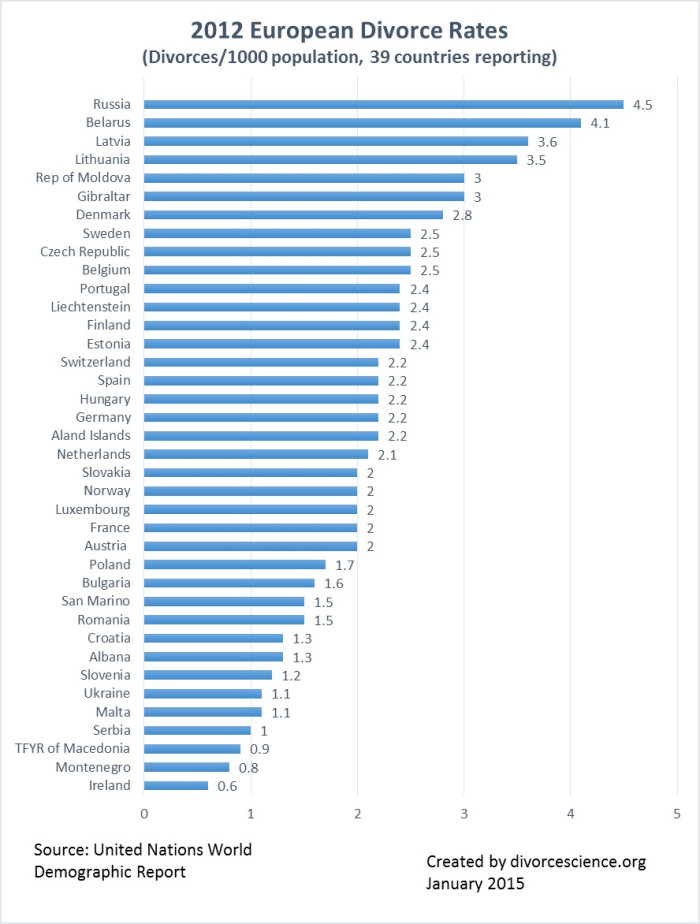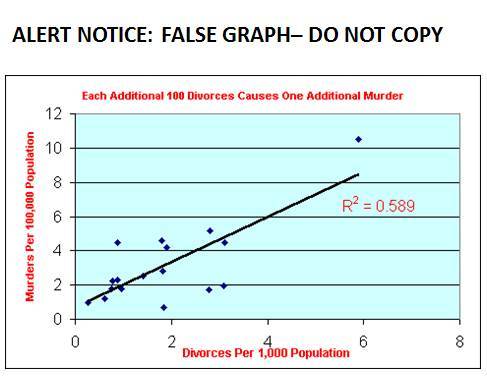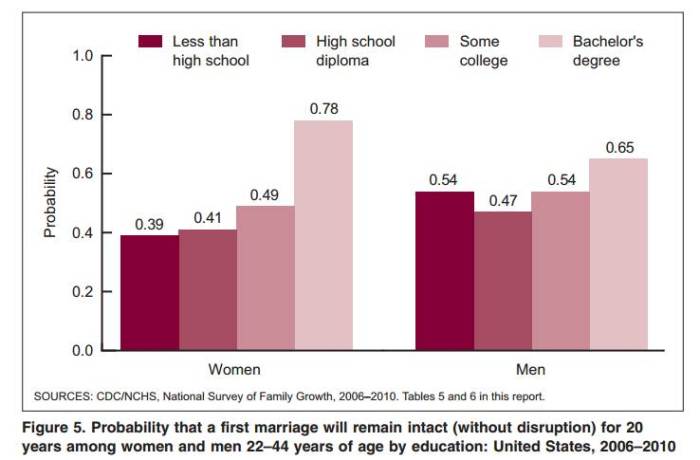Thirty-nine European countries have reported their divorce rates to the United Nations. Russia continues to have the highest divorce rate. Ireland has the lowest divorce rate.

Thirty-nine European countries have reported their divorce rates to the United Nations. Russia continues to have the highest divorce rate. Ireland has the lowest divorce rate.

The United Nations has released the latest divorce rate information. At present very few countries are included. For most of these countries there has been little change in the divorce rate since 2012. The original data are here. Also see the 2012 World Divorce Rates.
Philip N. Cohen, a sociologist at the University of Maryland, has developed an excellent blog, Family Inequality, in which he discusses a variety of inequality issues. He recently published a paper that explore the impact of the recession on divorce rates. (also discussed in this blog).
You can see more of his thoughts and analysis of divorce issues.
There is an old saying often attributed to Mark Twain that goes… “there are three kinds of lies: lies, damned lies and statistics.”
There are all types of misleading or false examples about divorce statistics by people who have a particular point of view about what meaning we should draw from rising or falling divorce rates.
Among the most troublesome examples is provided by this website which attempts to demonstrate that most of the worst problems in society (for example, murder, rape, armed robbery, etc.) are all the result of divorce. Below is a sample of one of the tables at this website. In this graph the author asserts that the divorce rate causes the murder rate to increase. However, all this graph really shows is that there is a correlation between the murder rate and the divorce rate. In statistics a fundamental idea is that the “correlation” between two numbers does not translate into a “causal” relationship. There are at least three hypotheses that can explain the correlation between rates of murder and divorce:
The only way to figure out what is causing murder or divorce rates from rising is to test many different hypotheses and control for some of the possible other factors that may be contributing to changes in the rates. It is important to test whether rates in one period of time predict future rates.
There are plenty of real consequences of divorce that should concern us without suggesting that all of society’s ills are the result of divorce.

 There is considerable evidence that suggests that women with more education are less likely to get divorced. In this chart from the National Center for Health Statistics, you can see the percentages of women with various amounts of education and they likelihood that there marriages will last 20 years. You can see that women with a college education are much more likely to have marriages that last over 20 years (about 80%). There is a similar trend for men, but it is less dramatic.
There is considerable evidence that suggests that women with more education are less likely to get divorced. In this chart from the National Center for Health Statistics, you can see the percentages of women with various amounts of education and they likelihood that there marriages will last 20 years. You can see that women with a college education are much more likely to have marriages that last over 20 years (about 80%). There is a similar trend for men, but it is less dramatic.
A comprehensive report on trends in US marriage and divorce rates can be found at the National Center for Health Statistics.
I just reviewed some of the latest demographic information about trends in terms of divorce rates in the US and around the world. Here are links to these updated summaries.
The United Nations publishes an Annual Demographic Year Book for 2011 includes a table of divorce rates for about 200 countries in the world. The data in this table are from the 2011 yearbook. Many countries have not reported their 2011 data, but some have made these reports. More reports on divorce rates around the world are reported here….
The United Nations publishes an Annual Demographic Year Book for 2011 includes a table of divorce rates for about 200 countries in the world. The data in this table are from the 2011 yearbook. Many countries have not reported their 2011 data, but some have made these reports. More reports on divorce rates around the world are reported here….
Only a few countries in the Middle East have reported their divorce rates, but this provides a sample of the patterns of divorce in these countries.
The United Nations publishes an Annual Demographic Year Book for 2011 includes a table of divorce rates for about 200 countries in the world. The data in this table are from the 2011 yearbook. Many countries have not reported their 2011 data, but some have made these reports. More reports on divorce rates around the world are reported here….